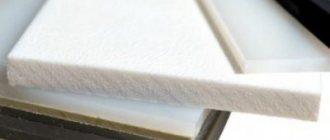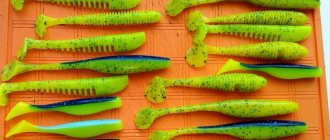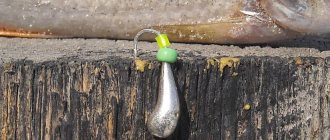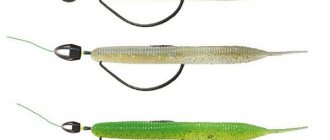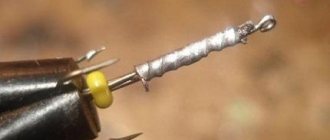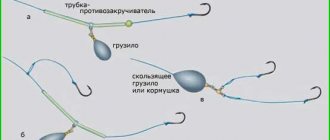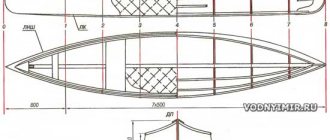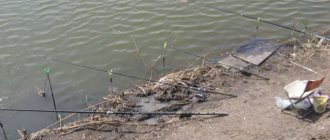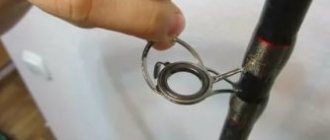Homemade lures for ultralight spinning rods
Lure with a propeller
When fishing with an ultralight spinning rod for medium-sized predatory and “peaceful” fish, miniature spinners work great, but finding baits with good characteristics on sale is quite difficult. They, of course, exist, but their price is no less than that of wobblers, since these lures are mostly handmade. Therefore, the loss of micro-spinners when hooked has a significant impact on the fishing budget. It is quite difficult to make a miniature working spinner of size 000 or 0000 yourself. Where is the way out?
When fishing with ultralight, a good alternative to a spoon with a petal can be a “turbo” bait with a propeller. What's good about a propeller?
Firstly, it is much easier to make a propeller rotate than a petal, which is especially important when fishing in the current. The propeller rotates when moving the spinner in any direction: downstream, against it or across it and at any speed, up to a complete stop. Even when the bait is in free fall, the propeller continues to rotate slowly.
Secondly, the deviation of the petal of the rotating spoon from the axis and the turbulence from it create a much greater visual volume than that of a bait with a propeller. While this attracts pike or perch, it rather scares away peaceful fish.
Another advantage of the propeller is that when moving along the surface of the water, it continues to rotate, unlike a spinner with a petal, which stops working fully when it reaches the surface. The same thing happens at the bottom. After a spinner with a petal malfunctions due to contact with algae or bottom soil, it needs to go some more distance to start again. And for the propeller to start working, the slightest separation from the obstacle is enough. The disadvantages of a propeller are the same as those of a blade - windage when casting and twisting of the line.
Making a “Turbo” spinner for ultralight.
Industrial “turbo” baits can be found on sale, but not in “micro” sizes.
There are, of course, expensive ones - “handmade”. We present to your attention a method for making microturbo baits at home.
The main part of the bait is the rotating element, or “propeller”. It requires special precision in manufacturing. You can use sheet brass, stainless steel or copper up to 1 mm thick. Using a hacksaw and a miniature vice, we cut the metal plate into blanks 6-8 mm wide and 2-2.5 cm long - for medium-sized propellers. The blanks can be either smaller or larger, but in approximately the same ratio of length and width.
Using a file or a small machine with a medium-grit emery stone, round off the ends and align the edges of the workpiece. In its center we mark and drill a hole of 0.8-1 mm.
During processing, the workpiece may become deformed. In this case, it can be clamped in a vice and straightened with a hammer on an anvil.
After drilling, sand the workpiece with fine sandpaper, leveling the surfaces. We place the workpiece on sandpaper, press the center punch into the center of the hole (so as not to get your hands dirty) and, pressing the workpiece, grind it off on both sides to a thickness of 0.7-0.8 mm. This is pre-grinding.
Then, having secured the workpiece in a vice, we grind out the contour of the propeller using needle files. After the propeller is machined, we perform control grinding using fine-grained (down to micron) sandpaper. We grind the workpiece down to 0.6-0.7mm and polish it. For this operation we use a common notebook, on the pages of which we apply GOI paste.
A machine with various attachments, including polishing ones, can greatly facilitate the process of making propellers.
After polishing, using two pairs of pliers (one of which should be thin-lipped and narrow-nose), we bend the blades. The blades must first be protected with electrical tape, adhesive tape or adhesive tape. It is better to use something that does not leave traces of glue on the surface. Using narrow-nose pliers, we clamp the propeller in the middle so that only the blades remain free; with the other, we bend the first blade at an angle of 40-45, at the same time turning it slightly around its axis.
Then we bend the second blade, turning it around its axis in the same direction as the first. The bend angle should be such that the propeller does not touch the core parts. Propellers with a sharper bend angle are used when fishing in moderate currents, and with a blunter one - in slow ones or where there is no current at all. This does not apply to the smallest propellers, which are not curved relative to the longitudinal axis. If everything is done correctly, then the propeller is ready.
The core is an important part of the bait. It can consist of one main part or several smaller ones.
We will need: beads of different sizes and colors, beads from jewelry, various parts of old “turntables” (cores, bumpers, beads).
The core from a large rotating spoon can be cut into two or even three parts. You will also need lead “olive” weights and drop-shaped weights with a through hole and a weight of up to 3 g. Also prepare a sufficient number of propellers with a length of 0.8 to 2.5 cm and a width of 0.4 to 0.8 cm.
The range of hook sizes is wide: from No. 12 to No. 6. When choosing a hook for a particular bait, visually focus on the size that you would choose for float fishing for a certain type of fish in specific conditions.
You will need triple and single hooks with both short and long shanks (several beads can be put on such a hook), with notches on the shank (you can attach pieces of worms, flies and other insects to them). It is easy to attach a whole microtwister or part of it to such hooks. Small fly fishing flies tied on a single hook, tees with an edge or an “eye”, used in winter fishing, go well with the propeller. The main thing is that the size of the hook matches the size of the propeller.
A large hook with a small bait can scare away the fish, and the miniature treble will be mistaken for the legs of an insect that it wants to eat. When choosing a hook, you need to take into account the conditions in which you will have to fish: in water free from obstacles or in snags overgrown with grass.
We attach a hook to one of the ends of a piece of guitar string No. 2, 6-8 cm long, or another steel wire suitable for our purpose. For this operation we use miniature narrow-nosed pliers from a pocket set, comfortable wire cutters and a nail of a suitable diameter. Using a nail, we make a loop, a future eye, insert a hook into it, insert the nail again and, using pliers, twist the wire 2-3 turns.
Advantages of fishing lines and braids
This choice often faces those who have started UL fishing. Indeed, a cord with a relative diameter of 0.06 mm holds approximately the same as a fishing line of 0.12-0.14, and the bait with it seems to fly further.
But the cord also has disadvantages, and there are many of them: very tough fishing due to zero elongation (many slips), it often gets tangled, especially when fishing by rafting, it wears out a lot when fishing on rocky rivers, it is an order of magnitude more noticeable in the water than a regular fishing line , not to mention fluorocarbon.
To some, the last argument will seem far-fetched - this is not a float, this is a spinning rod, where can the fish look at the fishing line? But in many situations we hold the bait almost motionless, playing along only with the tip of the spinning rod back and forth, and the water is clear, and the fish are not “crazy” - trout, grayling.
For myself, I have already definitely decided: everywhere except the jig, I use fishing line, preferably fluorocarbon. Although many “ultralighters” I respect use braid, 4Lb FireLine, the thinnest Gosen or other thin PE laces, and quite successfully.
It's a matter of taste and habit. Try both and settle on what you like.
Now it’s clear to us what gear can be called UL. What kind of fish can we catch with these “twigs” and “hairs”? This is the question I most often hear near a rack with UL spinning rods: “What kind of fish can I catch with this?”
“Any,” I answer, and I think I’ll be right. Let's start with the fact that UL fishing is not a means of “flooding the shore with blood”, grabbing fish, filling a bag and leaving.
UL fishing is an art, sophistication of tackle, sniper casts and chess game tactics. Here you can no longer stupidly and monotonously comb the edge, and when the fish comes out, fill it with as much as possible.
At UL you get pleasure from simply communicating with nature, with water and its inhabitants. Therefore, it is advisable to release fish caught in this way, if possible.
Of course, any type of fishing, even sea trolling, can be transferred from the rank of “fishing” to the category of “non-stupid enjoyment of the process,” but UL itself is suitable for this. Some fishermen don’t have enough money to live on, so they kill a lot of large fish.
Big bags. A lot of blood.
The baits are heavy. Very.
They like it. Them.
Not for us. Let be.
This is not written for them. They write themselves.
They kind of can. Some people read.
Some even understand. Me not.
I like a light, balanced tackle with a wobbler, a couple of centimeters long, morning, dew, the bank of a small stream. Cast to 5 meters – clearly under the branches of an overhanging willow bush.
Without closing the bow, rafting for 2-3 meters, the jet nails the wobbler to the shore pit. Here, 10 minutes ago, there was a “boom” barely perceptible in peripheral vision.
And here's what you need to know: Wobbler Rudra - reviews, price, video, analogue, Rudra 130 SP, description, where to buy?
We slowed down the bait, quietly closed the bow, lightly moved the tip of the spinning rod, the wobbler went 20 cm deep and began to play. “Tyk” is a fishing rod with an arc.
That's it, the first part of the buzz is there - the fish have been seduced. The second part has begun - adrenaline.
And a 600 g tongue on a 0.12 fishing line will seem like a blue marlin under a hundred kilos. And the third part of the thrill is taking a photo, carefully removing the fish, and releasing it.
She's free. She gave you a few minutes of happiness.
She deserved her freedom. She will thank you.
To you, or to those who come after you. Nature loves you.
Because you love her and everything connected with her. And you won’t leave a beer bottle behind and won’t listen to the tape recorder at dawn.
And you will listen to the singing of birds (mosquitoes) and listen attentively to the voice of the river, waiting for that treasured “boom”.
Well, before moving on to the main thing, fishing and lures, I will say a few words about the culture of fishing, or rather, taking fish. It’s just very disgusting to watch the “fisherman” kicking salmon onto the pebble shore.
Barbarism. And since we have already agreed that UL is not catch, but something closer to art, then it is advisable to take fish not anyhow, but correctly, that is, beautifully.
And I will try to tell you how to take the fish in the most beautiful way. Maybe I'm wrong about something, but that's what I do, and it turns out beautifully.
Trout and grayling - this fish practically never weighs more than a kilogram, and most often these are specimens weighing 200-500 g. There are two ways - either a small landing net, a fly fishing “racket”, or we take it with our hands.
Everything is fine with the landing net, this is done all over the world, the fish are practically not injured, and in many reservoirs of the world, fishing without a landing net is generally prohibited. Taking fish with your hand is another matter.
Try to take a trout from above one day - a sea of splash and solid muscles, slippery like soap, floated away. It is best to grab trout and grayling by the belly, carefully, gently, without squeezing, just place your palm and lift the fish out of the water.
It would be good to do this with gloves - this way the fish does not suffer thermal injury.
To summarize, we should name the advantages of monofilament lines and braided threads, and every novice ultralight angler will make his own choice. So, nylon fishing line has the following advantages:
- slippery structure facilitating long-distance casting of weightless ultralight baits;
- transparency and invisibility for fish;
- good shock-absorbing properties due to stretchability;
- low cost.
Braided cord, in comparison with monofilament, is endowed with the following positive properties:
- maximum sensitivity;
- higher strength;
- lack of memory.
There is also fluorocarbon fishing line, but it is rarely used as the main line on the spool due to its high cost and the ability to use only the thinnest diameters due to the rigidity of such fishing line.
Little secrets of wiring, or why a homemade micro-oscillator needs holes, a “fly” and a fisherman
I really liked ultralight baits with asymmetrical shapes. Here is one of them (photo 6). Please don't ask me why I drilled holes on the side of this micro-oscillator. I can't answer this question for you. There are many versions here. Firstly, in this way we somewhat lighten the lower part, and secondly, the micro-oscillator acquires additional acoustic properties. Which? I don’t know myself, but it seemed to me that such micro-oscillators bite not just better, but somehow more confidently, or something. Or is it just my imagination? I haven’t conducted any special research, I’m not a physicist, and certainly not an ichthyologist; I’m more interested in the end result.
I don’t recommend putting a “fly” on the tee of our micro-oscillators if you are going to fish with this ultralight bait in classic fishing. You will kill the entire “game” of the microoscillator. But with such a “dead” bait, with a “fly”, you can also catch well. But the wiring method will be completely different. And let's talk about it first, and then return to the “classics”.
Source
Ultralight turbines. #WITH YOUR OWN CURVES
Turbines for ultralight.
“Acquirers are taking over the World...
Previously, the world was captured by Genghis Khans,
Tamerlane, Macedonian. Now it's tight
and the acquirers inexorably seize..."
What is this epigraph for? And, in fact, only to emphasize the value of things that we do not acquire, but make ourselves, and to give such things some additional “romantic” aura.
In fishing, the question of “homemade products” comes up very often. Sometimes you want to save money by making, for example, jig weights. Sometimes creative impulses directed in the right direction lead to the creation, for example, of jerks and wobblers, which cannot be called anything other than a Work of Art (I have seen it on the site more than once). And sometimes we are driven to handicrafts by the banal lack of necessary items in stores... That’s how I started making turbines.
Having started ultralight, I quickly noticed that spinners of extra small sizes (00) did not meet my requirements from them. The operation of the petal was extremely unstable. Especially in locations with small rivers and streams. I remembered some program where they showed a bait with a propeller and that’s where it all started...
To date, I have already tried several variations of “turbine” class lures. I tried different shapes of the propeller, its proportions relative to the core, materials and shapes of the core, its different colors, experimented with hooks... And in this article I will offer my most extreme version of the “evolution” of this bait. Evolution, of course, in the “test tube” conditions of my home workshop).
The material will be the bottom of an aluminum drink can. Or its TOP END. The metal in these places is thicker. It does not deform when bitten, remaining light and easy to process for its thickness.
We open the bottom into strips of the required width (it’s convenient to use an angle grinder using thin disks, BUT FOLLOWING ALL SAFETY RULES! Because sawdust flies into your eyes, and sometimes the workpiece is pulled out of your hands. But you can get by with scissors).
What are the requirements for a spinning rod for perch fishing?
First of all, this is the minimum figure for the lower casting. If you are hunting for trophy fish or in strong currents, or fishing at great depths, you can also use a light spinning rod. But if you want to catch perch always and everywhere, then this figure becomes crucial. If the form says 0.6g, then such a rod is quite suitable.
At the same time, you need to ensure that the spread of numbers is not very large. For example, if the form says 0.5 – 21, then this should immediately alert you; as a rule, this does not happen. It is normal when the weight range does not exceed 10-15g.
Now about the coil. It should be in harmony with the rod. When ultralight fishing, two parameters of the reel are decisive: weight and correct placement of the cord or line. As a rule, coils from the 1000 series are used for ultralight. But you can also use other, larger coils, but this is less convenient.
Firstly, using a heavy reel will simply lead to your arms getting tired, and secondly, and this is the most important thing, it will be impossible to play the bait correctly. If the object of the hunt is mainly perch, then it is better to equip the reel with fishing line. It is very important here that the fishing line is wound as much as possible under the side of the reel.
This should reduce friction, especially in the early stages of casting, allowing you to cast the bait a little further than usual. In the case of fishing from a boat, this is not particularly important, since you can always drive up to where you need to go.
But if fishing is done from the shore, and the perch, for example, is standing at the edge, which is at the casting limit, then correct winding begins to play its role. After all, sometimes even an extra 50 centimeters matter.
Here's what you need to know: How to properly set up your fishing rod
The right baits for ultralight - types and features of use
The right lures for ultralight are an important link in building a UL spinning tackle. This is the final part of the equipment for which the rod, reel, and cord are sharpened and tuned. Compared to conventional spinning baits, ultralight ones are much smaller and lighter. They can catch not only predators, but also peaceful fish. Such features impose certain design requirements when using lures for ultralight spinning rods.
Ultralight spinning
The terms ultralight, micro, nano jig reflect the smallest caliber of spinning tackle. This allows the use of the smallest, lightest equipment. The set of ultralight baits, in addition to the standard ones, includes all the small things that can only be used with a bombard on a regular spinning rod. However, when catching small, cautious fish, bombards and rough spinning rods do not provide full contact with the equipment.
In urban areas where there are few fish, ultralight spinning is necessary. It is becoming increasingly difficult to find large fish in clogged city rivers and ponds. But you can always find small perch, pike or rudd. Ultralight also works in fishing areas. Here fishermen love it for its lightness, convenience, and thrill when fighting large fish.
Petal.
Which petal is preferable in a given situation? There are so many anglers, so many opinions. Some people like “Long” type lures, some like “Aglia” lures, and some like intermediate petals.
Let me remind you (roughly) that the narrower the petal, the smaller the angle of its deviation from the axis and the lower the resistance of the spinner when moving. Personally, when fishing at shallow depths, I prefer blades with a large deflection, and at relatively great depths and in the absence of current, I prefer blades with a small angle.
The thickness of the petal material in UL turntables is very important. The thinner the material, the easier the bait will be.
But you can’t overdo it, otherwise after the first fish you will get a “crumpled tin can” instead of a spoon. And when caught, the thin petal can become deformed.
We need to find a middle ground. The material for the petals can be copper, cupronickel brass, as well as any metal or alloy with similar properties.
The most universal petal color is white. Using waterproof felt-tip pens, you can give it any color right on the pond.
But personally, I rarely use anything other than a dull white petal with red dots/stripes. Yes, sometimes trout prefer dark (green) spinners, sometimes the tongue likes red-copper baits, but the most universal and trouble-free one is a white and red petal.
Spoons
The first bait for ultralight spinning is a spinner. Any micro-oscillators, micro-turntables of small sizes and weights are used. Fundamentally, the fishing technique does not differ from conventional spinning. The same uniform movements, stop and go, careful choice of place and fishing horizon.
Spinners
Ultralight uses small turntables in sizes 00.0 or one. Sometimes you come across smaller spinners in stores. Lures with both a regular round petal and a long long petal are suitable. In still water, spinners with a blade deflection angle of more than 60 degrees work better. In the current, on the contrary, it is better to start spinners with a slight deviation, less than 30 degrees.
Lure priority
In the ultra-light class, the importance of the bait is much more important than in any other form of spinning fishing. Perhaps only line fishing can compare with UL in terms of the importance of what is tied at the other end of the line.
If in jigging it is more important who is at that end of the tackle (that is, the angler himself), then in UL these two factors play almost an equal role. Of course, as in other types of fishing, a lot depends on how and where to cast, how to cast and where to slow down.
But making a small bait work is an order of magnitude more difficult than a large one. The small bait must be “licked” to the point of impossibility.
The “brand name” of the spinner does not play a special role in this case.
The set of basic types of UL lures is not much different from the standard spinning lure. Here is a brief classification:
- 1. Turntables
- 1.1. With rod weight
- 1.2. Front loading
- 2. Oscillators
- 2.1. Regular
- 2.2. With variable thickness
- 3. Wobblers
- 4. Jigs
- 5. Flies
- 6. Poppers
There are also a lot of baits that simply cannot be classified in any way. Moreover, their performance qualities can be very high, and in some situations these baits can become more catchy than standard ones. Among these “misunderstandings” we can name: a micro-popper torpedo with a propeller from Heddon;
And here’s what you need to know: Medium fast spinning rod structure - About fishing
a fly with a propeller attached to the fore-end of the hook; microspinnerbaits made on a small offset hook; composite oscillators; wobbler beetle and many other baits.
Wobblers
The next large group of ultralight baits are wobblers. You can use any microcranks, minnows, shads up to 5 cm in size and weighing up to 7 grams. More often, ultralight uses microcranks with one tee 2-4 cm long and weighing 1.5-5 grams.
As with wobblers in general, the selection of wiring for each specific model is important. There are no universal wobblers - each of them is tailored to specific fishing conditions. You can use both sinking and floating baits. However, wobblers most of all respect clean suspenders - baits that hang in the water column when stopped.
You can use both branded ultralight baits and Chinese ones from Aliexpress. However, you shouldn’t take everything. The peculiarity of China is that before purchasing you cannot be fooled by advertising or pictures - it is better to study reviews for a specific model. An obvious plus is the price. For the cost of one original wobbler you can buy a dozen Chinese ones, and some replicas work no worse than the originals.
In addition to standard wobblers, in ultralight sizes you can find poppers and bladeless ratlins, topwaters (pencils). Surface floats and vibes sometimes save fishing, especially in the summer, when nothing else works.
Article about the right wobblers for ultralight
Smith Camion
The Smith company from Japan is famous for its advanced wobblers. The products of this brand combine deep design, high-quality materials and advanced technical solutions. The prices are quite high, but this is not surprising.
Smith Camion is the brand’s flagship in the ultralight fishing direction. It was developed for trout, but has found application not only for trout. In our reservoirs, Kamions simply mow down chub, perch and other predators.
This crank is available in several versions. The basic version is 3.2 cm long and weighs 2.5 – 2.7 g. Enlarged formation, “Magnum”: 3.6 cm and weighs just over 3 g. All options are floating. There is a breakdown with different blades for different depths.
The key advantage is the Smith Camion's stability in the current. A strong jet, the convergence of several streams at different speeds - this is not an obstacle to this crank.
You can note the durable coating and a rich palette of colors. The pleasure is not cheap. But a spinning player who seriously relies on ultralight simply must have several Kamions. No matter how tolerable the clones are, in the fast current they all rest.
Microjig
A separate large direction of ultralight is microjig. Many anglers fish only with such baits, without using spoons or wobblers. Everything used is the same as in a regular jig - twisters, vibrating tails, larvae, crustaceans, worms, slugs, foam fish. Only the weight of jig heads and Cheburashkas, as well as the size of silicones, are selected accordingly for ultralight.
Foam rubber fish for ultralight are usually cut out and painted yourself; there are plenty of silicone baits available for sale for every color and taste. Installation - usual, on a jig head or swivel suspension with an offset hook. Spaced rigs also work - drop-shot, split-shot, drop-shot, Texas and Carolina. This is a matter of experimentation and manipulation on the reservoir with the selection of a catchable option.
Article about fishing with micro jig: link coming soon
Some anglers successfully use jigs instead of jigs. Using an ultralight spinning rod, you can fish both vertically from a boat and by casting, hooking it with silicone or natural bait. Among jigs there are simply many more options of shapes and colors than among jig heads or Cheburashkas. Jig weights of 0.5-5 grams are used, in accordance with the test of the working rod. More information about fishing with spinning jigs
Ultralight spinning rod is thin and delicate tackle.
I don’t really like to write about gear, especially about spinning rods, where the gear depends an order of magnitude less than, say, a float rod.
Despite this, I will dwell on some of the most interesting aspects of the “ultralight” equipment. He differs from all the others in the casting indicated on the form. Casting a spinning rod is indicated by two numbers, which indicate what weight of bait the rod is designed to cast. It is believed that ultralight baits weigh from 500 mg to 5 g. All baits that weigh more than 5g are no longer considered ultra-light.
There are many ultralight spinning rods, but medium-fast rods are considered the most popular because they have average parameters. This rod can be used for fishing with a wobbler, spinner or twister.
It feels good, allows you to make long casts and holds the fish well when playing. We can consider that a rod is good if it allows you to cast a bait weighing 2g further than twenty meters.
There are currently plenty of light baits, however, for special perch fishing, as a rule, three types of bait are used, which means three fishing methods. The first is a popper, a surface bait and really catchy, fishing with it is a pleasure because you can see the fish attack.
When using poppers, especially homemade ones, the by-catch may also include pike, which also greatly respects this bait. The second, and perhaps the most used bait is a spinner or, as it is also called, a spinner.
Until recently, a spinner was the only fisherman’s tool with which he could specifically, or at least purposefully, catch perch, although other predatory fish, such as pike, chub, and asp, can also be caught with a spinner.
And if such a spoon is well loaded, then pike perch and even catfish. For perch fishing, as a rule, spinners of sizes 0 and 1 are used. In rare cases, when large perch is being caught and in order to weed out small ones, number 2 is used. But both the spinner and the popper have lost their relevance with the advent of silicone baits, which are usually used for fishing with micro jig.
If we talk about fishing with a popper or a spinner, then although there are some requirements for the rod, they are still not critical. If we talk about microjig, then here you can thoroughly understand what casting a rod is.
This becomes important not only because the minimum figure indicates the weight of the bait that is used with this rod. But also the weight of the bait, which you can confidently feel and with which you can make conscious retrieving.
Flies and streamers
Ultralight allows you to use flies or streamers. This is especially useful when fishing for chub, sabrefish, grayling, and trout. Both dry and wet fly fishing flies and relatively large and heavy streamers are used. A streamer or a heavy fly of the appropriate weight can be cast simply with a rod.
Light flies can be mounted on an ultralight class spinning rod using a small bombard weighing 2-3 grams. Typically, bombard fishing is the prerogative of a medium spinning rod or special rods. However, you can also fish this way on ultralight - with Sbirulino floats of the appropriate size and weight.
Combined and homemade baits
If you hang a fly or streamer from a spinner or spinner, you get an ultralight hybrid bait, a fly-spoon. A fly wobbler is also made. Many fishermen do not use store-bought flies, but make their own barbs on their hooks using lint, thread, feathers or Lurex.
From foam or polyurethane foam you can make an ultra-light resemblance to a mandula for pike perch, only on a single hook. This micromandula works great against predators, especially bersh or perch.
Small spinnerbaits or homemade ultralight baits based on a similar principle are also suitable. With proper ingenuity, an additional micro-petal can be hung on any bait.
Recently, anglers have begun to use hard plastic epoxy baits, also made with their own hands at home. Compared to store-bought silicone sponges, epoxy resin fry are resistant to pike teeth and other damage. Most often perch is caught with such baits, but other fish also take them.
Source
